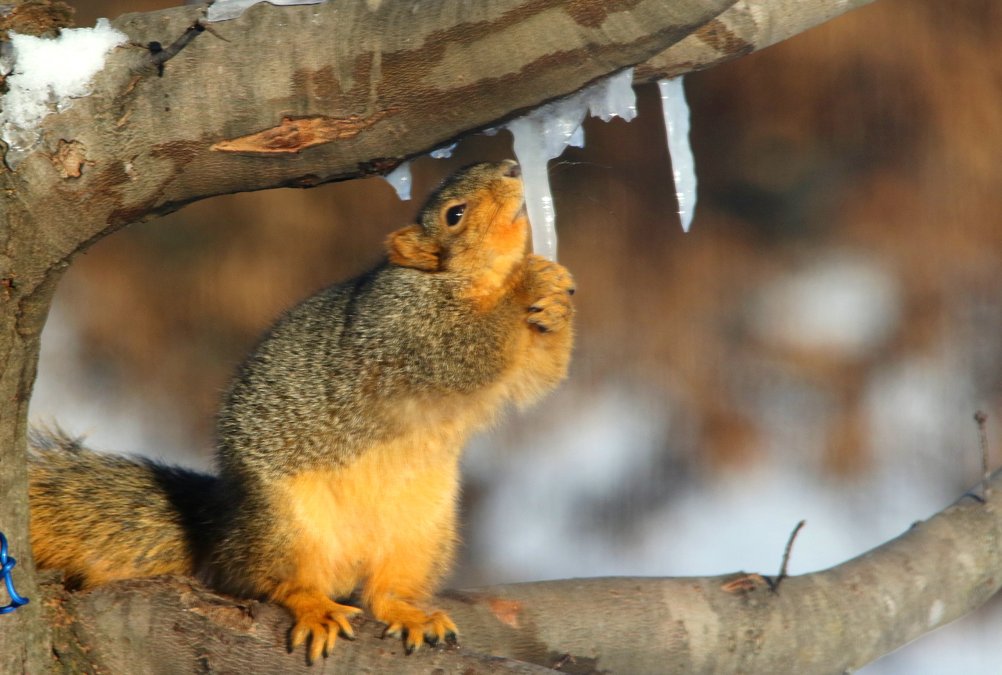The list of species flocking to leafless maple species, any Acer species, shows no favorites.
Winter birds galore include Red-bellied Woodpeckers, Black-capped Chickadees, and Tufted Titmice, join fox and gray squirrels to lick the branches, peck at sapcicles, drink from collecting cans, and challenge people who collect the juice in bags and pails.
Folks with no experience, including Nina Miller, and her legally blind husband, Roger James, purchased five acres in rural Town of Brigham in Iowa County. They found house they remodeled was surrounded by red and sugar maples, which held scars from past drill bits.
“We didn’t know a thing about it but figured we’re here so why not purchase items we need and give it a try for our tradition of Sunday morning pancakes,” Miller said.
She put a piece of white tape on the drill bit so when it reached the bark, the hole was deep enough into the xylem (wood).
Some of the neighbors were unfamiliar with the numerous collection “buckets” and methods used to collect sap that was carried to a put-together evaporator and upon seeing the blue bags wondered if the bags had anything to do with the spongy moth control. Nearby Amish prefer collection tubes for their more commercial-like operations.
“We found various web sites and Facebook pages very helpful regardless of one’s background and experience,” Miller added.
Collection has been brisk on sunny days this year and a lot earlier than most years.
I tapped one tree years ago and attached an open lid soup can to the trunk of a hybrid red-silver maple tree. Each years it’s reattached. The flowing sap drips fill the can and makes a fine feeding utensil for birds and squirrels. Overnight freezing, held back a bit by the sugar content of the sap, doesn’t deter animals waiting for thawing and dripping to begin.
Pictures of squirrel holding onto sapsicles or licking them seem to be worth more than the syrup at a farmer’s market.
One neighbor, starting from nothing, is now teaching those wanting to try in their lawns and kitchens. He got so involved he move his taps to white birch trees after the maple flow tails off. Because of the low sugar in birches with a 100:1 ratio, he finds drinking the liquid as rewarding as the more viscus fluid dribbled on waffles.
Sugaring has been tried by all types and shows that picking up on outdoors recreation ventures are boundless, helpful information is abundant, and rewards can be measured in numerous ways.
Wild food is once again more accessible in stubble fields for deer, turkeys and squirrels. Soybeans and corn dominate the menu.
This return to more abundant meals has frustrated a team of University of Wisconsin-Madison researchers who set out to study the social behavior of male whitetails relative to chronic wasting disease. Instead of taking corn or apples from an aluminum pan, the deer all of a sudden have become more inclined to eat waste grains and greening grass.
Each deer drop-netted is fitted with an elaborate collar that not only records where the deer has been but takes photographs of what goes on just beyond the animals’ noses, such as licking and nosing objects and items.
After a year, less if the deer has an accident and dies, the collar and camera A are dropped and give a signal the researchers can use to find the entire apparatus. A clock system sets set off a tiny explosion opening the collar so it breaks free and falls. The digital recordings are then available to ascertain.
The WDNR’s annual Ethical Hunter committee is still accepting public nominations. Call Davis at the number below for more information regarding this endeavor now in its 25th year and cosponsored by Vortex Optics in Barneveld.
Notice numerous changes and occurrences now appearing including shed antlers, nesting Bald Eagles, flowering skunk cabbage, enlarging flower buds on trees and shrubs, gobbling turkeys and crowing pheasants.
Contact Jerry Davis, a freelance writer, at sivadjam@mhtc.net or
608.924.1112.





